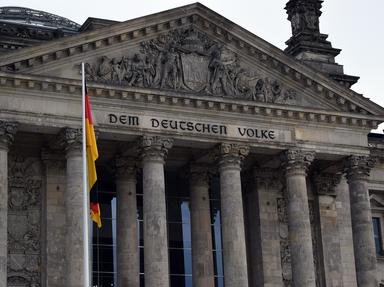Quiz Answer Key and Fun Facts
1. Frederick the Wise (Friedrich III) may be best known as Martin Luther's protector. Which German state, with its capital at Dresden, did Frederick rule as Elector?
2. When Napoleon Bonaparte created the Confederation of the Rhine in 1806, he raised one particular landgraviate to the status of a grand duchy. A German federal state today with its capital at Wiesbaden, Americans may be familiar with the name as the source of German mercenaries used by George III against the colonists in the Revolution. Which state is it?
3. Re-established as a kingdom in 1806, this state was ruled by a "Mad King" in the 1860s and '70s. Known for its castles, which German state is this, which today is the largest federal state in Germany?
4. Under the Holy Roman Empire, several German cities enjoyed the status of free imperial cities. That is, they were not "territorial cities" under the control of a prince or bishop or other ruler. Which of the following was NEVER a free imperial city?
5. Napoleon Bonaparte's brother Jerome ruled a kingdom with this name from 1807 to 1813. Its name is also familiar from two treaties signed in 1648 ending the Thirty Years' War. What is the name of this state that has existed in various forms since the early Middle Ages?
6. Once known as the Northern March, our next state later had the statuses of Margraviate, Electorate, and Province of Prussia. Surrounding Berlin, which state is this whose name was also given to six concertos by Johann Sebastian Bach?
7. The Congress of Vienna established this state as a kingdom in 1814, which only lasted until being conquered by Prussia in 1866 and reduced to a province. While still an electorate of the Holy Roman Empire in 1714, it was joined in a personal union with Great Britain. Name this German kingdom whose entire roster of kings included only five men, three of whom were named George (III, IV, and V).
8. Frederick I was the first king of another German kingdom, which existed from 1805 to 1918. From his capital at Stuttgart, this 6' 11", 440-pound ruler saw his lands pass from duchy (he was its last Duke) through electorate (1805-06) and on to kingdom. Which kingdom was this that lay just north of Lake Constance between Bavaria and Baden?
9. Ruled by the House of Hohenzollern, this kingdom became one of Europe's most powerful under such kings as the "Soldier King" Frederick William I and his son, Frederick the Great. Under William I (Kaiser Wilhelm I), it would establish the German Empire. Which kingdom is this?
10. Early rulers of our final state included Albert the Tall, Albert the Fat, Otto the Mild, Magnus the Pious, Magnus II with the Necklace, William the Victorious (twice) and Henry the Peaceful. Which north central duchy was this, which succeeded a principality of the same name combined with Wolfenbüttel?
Source: Author
shvdotr
This quiz was reviewed by FunTrivia editor
bloomsby before going online.
Any errors found in FunTrivia content are routinely corrected through our feedback system.
